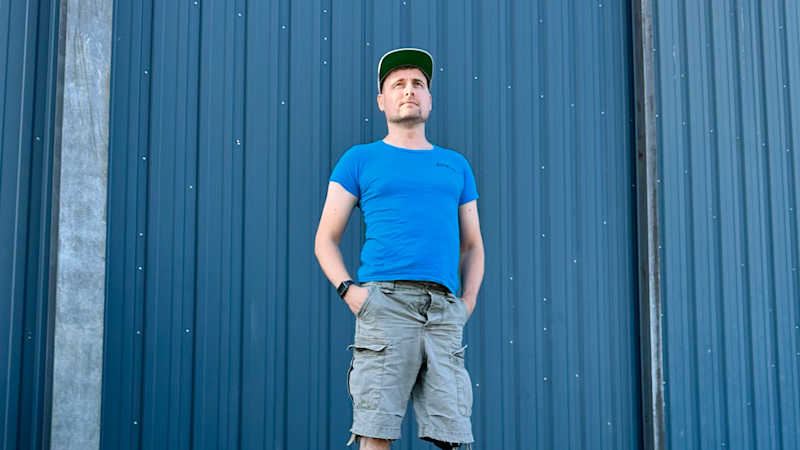The sky has no limits: A parachutist with a smart prosthesis is back in the air
An accident changes Jörg’s life – today he is bringing movement to inclusive sports with para skydiving

Friday, 16 May 2025
Jörg Schmidtke (42), who is from near Hamburg, nearly lost his life while skydiving in May 2017 following a momentous mistake. The then 34-year-old spent several weeks in a coma – while his family was frantic with worry – and his lower left leg had to be amputated due to circulatory disorders.
But the sports fan and IT consultant gradually reclaimed his day-to-day life – and the sky – after a fall from a height of 30 m.
In his free time, as well as enjoying indoor para skydiving in a wind tunnel, Jörg also campaigns for more inclusion in sports and is doing pioneering work in partnership with the “Para-TAKEOFF” project.
The smart, high-tech prosthesis supports Jörg continuously while walking, meaning he expends less energy. His favourite features are the support while climbing stairs and the stand-to-walk and walk-to-run functions – so he can spontaneously speed up to catch the bus or slowly move forward in the queue for a concert.
Between the sky and the horizon: How Jörg becomes a parachutist
Jörg Schmidtke’s childhood playground was the airfield where his father worked as a mechanic and co-pilot in the GDR. Even as a child, Jörg – who was born in Norderstedt – loved spending time in the air and wanted to become a pilot. He developed a great love – the love of being far away from everyday life, the feeling of freedom and tranquillity around him. Jörg started skydiving at the age of 21, and by 28 he is in the air at every opportunity. Sports became not just a hobby for him, but a way of life, as Jörg explains: “You can’t get these pictures and moments out of your head anymore. It’s indescribable, and it’s difficult to understand if you have never been parachuting. It’s an incredible feeling of freedom and happiness to be out in the air.”
As an adult, the IT consultant and sports fan had undergone the necessary training, had years of experience to bring to the tarmac and was a confident parachutist who was spending almost every free weekend going skydiving in preparation for the German Championships. In winter, he would hone his technique doing indoor skydiving in a wind tunnel. He would also use CrossFit, cycling and swimming to keep fit between skydiving sessions. All of which means that, by 2017, he had jumped from an altitude of 4,000 m around 1,400 times. He knew the procedure in his sleep and modified the harness himself.
A moment that changes everything
But in May 2017, everything changed: Jörg swapped his equipment and rebuilt parts. Changes that were not double-checked by his parachute rigger because they missed each other. On the following weekend, the first twenty jumps went well. But then one of the connections he had made himself came loose and the parachute folded from a square to a triangle shortly before landing, resulting in Jörg falling from a height of 30 m.
A rescue helicopter brought the then 34-year-old to Rostock University Hospital. He went into a coma; numerous organs were damaged and his blood circulation was disrupted. Fortunately, after three and a half weeks and numerous operations, Jörg’s condition stabilised and he woke up, albeit without remembering what happened to him. He quickly realised that one of his legs was shorter and somewhat lighter. His parents had to make the decision to have his left leg amputated above the knee in order to save his life.
How Jörg finds his way back to an independent life
Jörg only remembers fragments of the initial period after the accident. Later on, an intensive care doctor told him, “Your fitness level and your optimism were crucial”. Because the psychological stress was almost greater than the physical strain: He had to accept the amputation and learn to deal with his feelings of guilt. “What happens next? How do I want to live? What will I do in the future?” These are the kinds of existential questions that Jörg was asking at that time.
While he was in hospital and in rehab, his main focus was on adjusting to his new situation and getting back on his feet. “I want to do everything that’s possible again” – this was the goal that Jörg set himself, and he was able to draw a great deal of strength from this will – and from the support of his family, friends and colleagues. He started establishing his own routine again early on in his rehabilitation and was able to pick up his life from before the accident: He returned to his job as an IT consultant – working two hours a week – at an early stage of the rehabilitation process following consultation with his doctor.
“I can walk as if I didn’t have a prosthesis”
While he was still in the intensive care unit, Jörg received his first mechanical interim prosthesis, which he used for exactly one year. But the socket did not fit properly, which made walking much more difficult for him, as he developed pressure points and blisters. When talking to other amputees, Jörg realised just how important it was to have the right O&P professional there to support him. When trying out various prostheses, he felt safest with Ottobock’s Genium microprocessor knee, especially since it was crucial for him to avoid falls due to his abdominal injuries. The artificial leg replacement carried him through life for six years and helped him reclaim his normal routine. “A real game changer,” he recalls.
Jörg has now been wearing the Genium X4, the latest generation of the smart knee joint, for almost a year. He is particularly aware of the benefits in moments that people without disabilities take for granted. “Use the X4 for ten minutes and you’ll never want anything else again,” he says. “It’s helped me enjoy walking again and I can walk as if I didn’t have a prosthesis. The stair climbing function, for example, helps me save much more energy when going up steps at the station. And the stand-to-walk function lets me take small, precise steps forward in a queue at a concert or a shop without kicking anyone accidentally due to the stride being too long. With the Genium X4, you can spend much less time thinking,” says Jörg, reflecting on his favourite features.
All in all, he can walk more safely and comfortably. He also appreciates practical features such as the charger with a conventional USB cable and the long battery life. And almost as important: His prosthesis looks “cool”. Jörg opted for a black cover – as “cyborg-like as possible,” as he says. He wears shorts in the summer and shows his prosthesis openly, but few people notice it at all – children are most likely to notice that he has a leg amputation and tend to react with curiosity.
“Technology should provide us with meaningful support in everyday life. This is precisely what we want to achieve with the Genium X4. Through innovation and user-friendliness, we have created a prosthesis that adapts to everyday life and supports people with amputations in situations where they would otherwise come up against limits. Not only do our prostheses help our users gain more mobility, they also promote their independence and quality of life,” says David Wucherpfennig, market manager in prosthetics at Ottobock.
Pioneering role: Indoor para skydiving as an inclusive sport
“I don’t have any limitations in terms of my life,” says Jörg today, eight years after the accident. He has even managed to reclaim his love of flying thanks to indoor skydiving. “I look for solutions and don’t get hung up on problems,” is his motto. Even before the accident, he would use the indoor option as a training facility to hone his precision and practise new moves. In 2019, he went back to the wind tunnel for the first test – something he had been desperate to do for a long time. And sports continue to play an important role in his life outside the wind tunnel as well.
Jörg volunteers with the “Para-TAKEOFF” inclusion project and helps to organise inclusive indoor skydiving events. This allows people with disabilities – from amputation to spasticity to paraplegia – to fly in the air stream under supervision. “Being in a wind tunnel is like floating or swimming in the water. You don’t have to think about your disability anymore. The enthusiasm is really palpable; people forget their worries and we make them happy,” says Jörg, explaining his commitment. “Whether someone has a disability or not – everyone can fly.”
The project, which aims to promote more inclusion in sport, is truly pioneering. In cooperation with the German Parachuting Association (DFV), a new – and now international – competitive discipline has been developed in less than three years: indoor para skydiving (IPS). Athletes with a disability compete with the goal of completing a course in a wind tunnel as quickly as possible. A coefficient for the allocation of points and comparability is determined in advance on the basis of the degree of disability.
In addition, the project is working with wind tunnels to train instructors throughout Germany to enable more people with disabilities to practise indoor skydiving while ensuring their safety. There are currently about ten trained instructors in Berlin and Munich who make the parasport accessible and inclusive.
“I wish we could offer indoor skydiving on prescription one day,” says Jörg. “It’s like mini-therapy and gives people self-confidence. And people with disabilities should be able to experience flying as cheaply as possible or ideally free of charge, because having a disability itself entails such high costs.”
Jörg’s wishes for the future
Above all, Jörg advises people in similar situations to seek help – from specialists, people with the same disability, friends and family. This sets the course for the best possible treatment so you can start to enjoy life again. “Even though the journey may be long and it may not turn out as expected, in the end there’s always a solution,” Jörg concludes.
His own wish is to take part in a large outdoor skydiving formation one day. And at the indoor skydiving championship, he wants to compete as a disabled person in a non-disabled discipline.
Even though Jörg has pushed the limits of what is possible more than once, his accident has taught him to be aware of his own limits and to enjoy life with his loved ones. And this is precisely the feeling that he will be taking with him on the next jump – whether it’s from many metres up in the air or in a wind tunnel.
Overview: Genium X4 from Ottobock
Microprocessor-controlled prosthetic knee joint with intelligent sensors
Enables an optimised physiological gait (OPG 3.0) for a smooth gait feeling
Can negotiate uneven ground, slopes and stairs with the greatest possible support
Start-to-walk function makes it easy to initiate the first step with the prosthesis side
Dynamic backward movement ensures safe backward step
Requires fewer compensating movements and less physical exertion – secondary damage is reduced
With the connectgo.pro app, O&P professionals can fine-tune the prosthesis and provide the best possible support for the individual gait
Waterproof (IP68) and corrosion-resistant
Long battery life of up to five days and quick-charge function
MyModes allow users to make individual adjustments via an app for work, leisure, sports and more for personalised everyday use
Individual visual design possible by spraying and using stickers on protectors
Additional links
Instagram: Strong.schmiddl
Photos © Ottobock / private: https://we.tl/t-Z4mEuWNUyO

